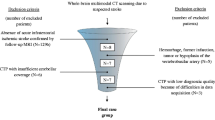Abstract
Purpose
The aim of this study was to verify the sensitivity and specificity of the hyperdense middle cerebral artery sign (HMCAS) obtained by multidetector computed tomography (CT) in predicting acute stroke, using diffusion-weighted (DW) magnetic resonance imaging (MRI) as a reference. The location of the HMCAS, the extension of the ischaemic lesion and its prognostic value were also assessed.
Materials and methods
The CT examinations of 654 patients with symptoms related to acute cerebral stroke were retrospectively reviewed. DW-MRI confirmed recent stroke in 175 patients. Two expert neuroradiologists analysed the CT examinations of these patients in four phases. Sensitivity, specificity and interobserver reliability was evaluated. Patients were divided into three groups according to the HMCAS site (M1–M2–M3) and the Alberta Stroke Program Early CT Score (ASPECTS) on DW-MRI was calculated. The ASPECTS average score was correlated with the National Institutes of Health Stroke Scale (NIHSS) and modified Rankin scale (mRS) at 3 months.
Results
In 41 patients, the presence of HMCAS was confirmed (71 % sensitivity; 100 % specificity; Interobserver reliability k, 84 %). An inverse correlation was found by comparing the ASPECTS and NIHSS scores (Rsq = −0.206). After logistic regression analysis, HMCAS was found to be independently associated with a poor outcome (mRS >2) at 3 months after adjusting for age, NIHSS on admission, risk factors and aetiology of stroke.
Conclusions
Our study demonstrated that HMCAS obtained with multidetector CT can be detected in more than 70 % of patients with large acute ischaemic lesion and it is an unfavourable prognostic sign.


Similar content being viewed by others
References
Gács G, Fox AJ, Barnett HJ, Vinuela F (1983) CT visualization of intracranial arterial thromboembolism. Stroke 14:756–762
Pressman BD, Tourje EJ, Thompson JR (1987) An early CT sign of ischemic infarction: increased density in a cerebral artery. AJR Am J Roentgenol 149:583–586
Tomsick TA, Brott TG, Olinger CP et al (1983) Hyperdense middle cerebral artery: incidence and quantitative significance. Neuroradiology 31:312–315
Leys D, Pruvo JP, Godefroy O et al (1992) Prevalence and significance of hyperdense middle cerebral artery in acute stroke. Stroke 23:317–324
Von Kummer R, Meyding-Lamade U, Forsting M, Rosin L et al (1994) Sensitivity and prognostic value of early CT in occlusion of the middle cerebral artery trunk. AJNR Am J Neuroradiol 15:9–18
Wolpert SM, Bruckmann H, Greenlee R et al (1993) Neuroradiologic evaluation of patients with acute stroke treated with recombinant tissue plasminogen activator. The rt-PA Acute Stroke Study Group. AJNR Am J Neuroradiol 14:3–13
Flacke S, Urbach H, Keller E et al (2000) Middle cerebral artery (MCA) susceptibility sign at susceptibility-based perfusion MR imaging: clinical importance and comparison with hyperdense MCA sign at CT. Radiology 215:476–482
Kim EY, Lee SK, Kim DJ et al (2005) Detection of thrombus in acute ischemic stroke: value of thin-section noncontrast-computed tomography. Stroke 36:2745–2777
Bastianello S, Pierallini A, Colonnese C et al (1991) Hyperdense middle cerebralartery CT sign. Comparison with angiography in the acute phase of ischemic supratentorial infarction. Neuroradiology 33:207–211
Berge E, Nakstad PH, Sandset PM (2001) Large middle cerebral artery infarctions and the hyperdense middle cerebral artery sign in patients with atrial fibrillation. Acta Radiol 42:261–268
Pexman JH, Barber PA, Hill MD et al (2001) Use of the Alberta Stroke Program Early CT Score (ASPECTS) for assessing CT scans in patients with acute stroke. AJNR Am J Neuroradiol 22:1534–1542
Weimar C, Ziegler A, Konig IR et al (2002) Predicting functional outcome and survival after acute ischemic stroke. J Neurol 249:888–895
Weimar C, Mieck T, Buchthal J et al (2005) Neurological worsening during the acute phase of ischemic stroke. Arch Neurol 62:393–397
Amarenco P, Bogousslavsky J, Kaplan LR et al (2009) Classification of stroke subtypes. Cerebrovasc Dis 27:493–501
The National Institute of Neurological Disorders and Stroke rt-PA Stroke Study Group (1995) Tissue plasminogen activator for acute ischemic stroke. N Engl J Med 333:1581–1587
Wahlgren N, Ahmed N, Dávalos A, The SITS investigators et al (2007) Thrombolysis with alteplase for acute ischaemic stroke in the Safe Implementation of Thrombolysis in Stroke-Monitoring Study (SITS-MOST): an observational study. Lancet 369:275–282
Barber PA, Demchuk AM, Hudon ME et al (2001) Hyperdense sylvian fissure MCA "dot" sign: a CT marker of acute ischemia. Stroke 32:84–88
Moulin T, Cattin F, Crepin-Leblond T et al (1994) Early CT signs in acute middle cerebral artery infarction: predictive value for subsequent infarct locations and out come. Neurology 47:366–375
Somford DM, Nederkoorn PJ, Rutgers DR et al (2002) Proximal and distal hyperattenuating middle cerebral artery signs at CT: different prognostic implications. Radiology 223:667–671
Schuierer G, Huk W (1988) The unilateral hyperdense middle cerebral artery: an early CT-sign of embolism or thrombosis. Neuroradiology 30:120–122
Tomsick T, Brott T, Barsan W et al (1996) Prognostic value of the hyperdense middle cerebral artery sign and stroke scale score before ultraearly thrombolytic therapy. AJNR Am J Neuroradiol 17:79–85
Conflict of interest
Romano Andrea, Biraschi Francesco, Tavanti Francesca, Beccia Mario, Dilisi Filomena, Castrignanò Antonella, Giuliani Giorgia, Pierallini Alberto, Fantozzi Luigi Maria, Rasura Maurizia, Bozzao Alessandro declare no conflict of interest.
Author information
Authors and Affiliations
Corresponding author
Rights and permissions
About this article
Cite this article
Romano, A., Biraschi, F., Tavanti, F. et al. Role of multidetector CT in the recognition of hyperdense middle cerebral artery sign (HMCAS) in patients with acute cerebral ischaemia: correlation with DWI-MRI sequences and clinical data. Radiol med 120, 222–227 (2015). https://doi.org/10.1007/s11547-014-0424-x
Received:
Accepted:
Published:
Issue Date:
DOI: https://doi.org/10.1007/s11547-014-0424-x




